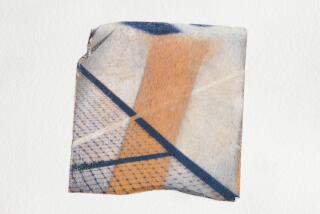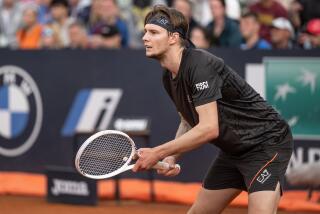Qualifying for U.S. Open Becomes Child’s Play
- Share via
Wild cards for the U.S. Open were flying last week, landing in the hands of America’s kids. The U.S. Tennis Assn., stepping up its search for the next Pete Sampras and Andre Agassi, went young and younger.
Insiders recognized most of the names, among them Taylor Dent, Mardy Fish, James Blakeand Robby Ginepri. Levar Harper-Griffith was a Davis Cup practice player on John McEnroe’s great adventure to Zimbabwe in 2000. Then there was the mysterious Hugo Armando, virtually unknown in the United States but gaining experience on European clay courts.
All are 23 or younger.
The best thing about youth is the future. Older players have baggage and losses to weigh them down, no matter the sport. Years ago, the Kings were raving about the great young players they acquired in the Wayne Gretzky trade with St. Louis.
A veteran hockey writer from Vancouver looked at the names and shook his head.
“There are old stiffs, but remember, there are young stiffs too,” he said.
The USTA’s youth movement buys time, and naturally, the nature of the wild-card process often spawns controversy. In the ATP’s Entry System rankings, Cecil Mamiit of Los Angeles (No. 107), Paul Goldstein (No. 154) and Justin Gimelstob (No. 175) were ahead of Fish and Harper-Griffith.
But Mamiit and Goldstein turned 25 this summer, and Gimelstob is 24. The three have been helped by the USTA in the past, and familiarity, plus the influx of younger American pros, seemed to hurt their prospects.
Mamiit, who beat Gimelstob at last week’s tour stop in Washington, had a mixed reaction when he received the news he would need to qualify for the U.S. Open.
“It was a very hard day,” Mamiit said. “I was really down. I wasn’t talking to too many people. It was kind of a shock and a disappointment. I wasn’t mad at anybody. It was a tough bite to swallow. A lot of the USTA coaches feel for me. It’s their decision and I guess they just want to go with the younger guys.
“Me, Goldstein and Gimelstob were in the running. If I got the wild card, they would be holding out on them. I think [USTA officials] tried too hard to make everybody happy. If they go with the best young guys, they can’t go wrong. If they mix it up with both, they’re holding out on some of the young guys and old guys.”
Mamiit was not bitter. He said he appreciated the USTA’s past assistance, having received a wild card into the U.S. Open last year.
This year, Mamiit beat Todd Martin in the first round of the French Open, and took two-time champion Yevgeny Kafelnikov to four sets in the second. If an 18-year-old American had taken Kafelnikov to four sets, however, it’s a decent assumption that the bandwagon would have picked up a few extra passengers.
“Now people want something new,” Mamiit said. “They go and see young players. Who is the next American? The opposite of the old generation, Pete and Andre, is going young with everything. I guess they don’t trust the middle.”
Still, the snub may not be the worst thing.
Mamiit has done the qualifying gig. After an injury-marred 2000, he qualified at the French Open and Wimbledon this year. He had suffered through a summer of first-round losses at Los Angeles, Montreal and Cincinnati before falling to Guillermo Canas of Argentina in the second round at Washington last week.
Mamiit wondered whether there might be less pressure on him without the wild card and USTA support.
“I hope I don’t take it into too much consideration,” he said. “The USTA has helped me a lot, so much that I had to do well for them. Now they gave me a sign to go on with myself, so I feel I can do things for myself.”
Wild Cards, Part II
It’s difficult to take the wild-card process seriously when you look at the case of Torrey Gambill, the younger brother of Jan-Michael Gambill. Ramon Delgado of Paraguay beat Torrey, 6-0, 6-0, in the first round of qualifying at last week’s Washington event. Later, Torrey received another wild card in the doubles main draw. The wild-card entry of Trevor Spracklin and Carl Clark beat the Gambills, 6-2, 6-4.
“The foreigners even think it’s a joke--they’re laughing at us,” said one tour player earlier this month.
The Gambills have yet to win a set in a seven tour events. One of the losses (6-2, 6-2) was to Andrea Gaudenzi and Goran Ivanisevic in Memphis in February.
Ivanisevic recalled the one-sided match in his usual amusing way.
“He’s a nice guy, you know,” he said. “He’s a lefty like me and he kept looking at me like I was his idol. He lost, 6-0, 6-0, [in singles] and loses easy matches. He’s trying so hard and you have to give him something for his effort. If I lost three times, love and love, I don’t think I’d play tennis anymore.”
So was Torrey of ATP caliber?
“I don’t think so,” Ivanisevic said. “But he has somebody, there’s always somebody--a brother, a sister, you know, somebody. This way he’s lucky because he has one of the best players of the future to help him. I’m not sure how long he’ll try, but at least he’s trying.”
More to Read
Go beyond the scoreboard
Get the latest on L.A.'s teams in the daily Sports Report newsletter.
You may occasionally receive promotional content from the Los Angeles Times.











